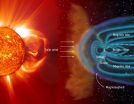(Press-News.org) A University of Southampton researcher has helped solve a long standing space mystery - the origin of the 'theta aurora'.
Auroras are the most visible manifestation of the Sun's effect on Earth. They are seen as colourful displays in the night sky, known as the Northern or Southern Lights. They are caused by the solar wind, a stream of plasma - electrically charged atomic particles - carrying its own magnetic field, interacting with the earth's magnetic field.
Normally, the main region for this impressive display is the 'auroral oval', which lies at around 65-70 degrees north or south of the equator, encircling the polar caps.
However, auroras can occur at even higher latitudes. One type is known as a 'theta aurora' because seen from above it looks like the Greek letter theta - an oval with a line crossing through the centre.
While the cause of the auroral oval emissions is reasonably well understood, the origin of the theta aurora was unclear until now.
Researchers observed particles in the two 'lobe' regions of the magnetosphere. The plasma in the lobes is normally cold, but previous observations suggested that theta auroras are linked with unusually hot lobe plasma.
Dr Robert Fear from the University of Southampton (formerly at the University of Leicester, where much of the research took place), and lead author of the paper published in Science this week, says: "Previously it was unclear whether this hot plasma was a result of direct solar wind entry through the lobes of the magnetosphere, or if the plasma is somehow related to the plasma sheet on the night side of Earth.
"One idea is that the process of magnetic reconnection on the night side of Earth causes a build-up of 'trapped' hot plasma in the higher latitude lobes."
The mystery was finally solved by studying data collected simultaneously by the European Space Agency's (ESA) Cluster and NASA's IMAGE satellites on 15 September 2005. While the four Cluster satellites were located in the southern hemisphere magnetic lobe, IMAGE had a wide-field view of the southern hemisphere aurora. As one Cluster satellite observed uncharacteristically energetic plasma in the lobe, IMAGE saw the 'arc' of the theta aurora cross the magnetic footprint of Cluster.
"We found that the energetic plasma signatures occur on high-latitude magnetic field lines that have been 'closed' by the process of magnetic reconnection, which then causes the plasma to become relatively hot," says Dr Fear.
"Because the field lines are closed, the observations are incompatible with direct entry from the solar wind. By testing this and other predictions about the behaviour of the theta aurora, our observations provide strong evidence that the plasma trapping mechanism is responsible for the theta aurora," he adds.
"The study highlights the intriguing process that can occur in the magnetosphere when the interplanetary magnetic field of the solar wind points northwards," adds Philippe Escoubet, ESA's Cluster project scientist.
"This is the first time that the origin of the theta aurora phenomenon has been revealed, and it is thanks to localised measurements from Cluster combined with the wide-field view of IMAGE that we can better understand another aspect of the Sun-Earth connection," he adds.
INFORMATION:
PROVIDENCE, R.I. - Where you live affects the type of bacteria that cause bloodstream infections, according to researchers at Rhode Island Hospital and an international team of investigators. The closer you live to the equator, the greater the likelihood of a bloodstream infection caused by a group of bacteria called Gram-negative bacteria, which thrive in warm and moist environments, compared to another group of bacteria referred to as Gram-positive bacteria. The study also found that the proportion of a country's GDP spent on health care impacted the type of bacteria ...
DALLAS - Dec. 18, 2014 - Retroviruses are best known for causing contagious scourges such as AIDS, or more sporadically, cancer.
But researchers at UT Southwestern Medical Center and Karolinska Institutet in Stockholm, Sweden, found that endogenous retroviruses (ERV) also play a critical role in the body's immune defense against common bacterial and viral pathogens.
"Most scientists have become used to the view that retroviruses are generally harmful," said Nobel Laureate Dr. Bruce Beutler, Professor and Director of UT Southwestern's Center for the Genetics of Host ...
Primates visually recognise and determine the category of an object even at a brief glance, and to date, this behaviour has been unmatched by artificial systems. A study publishing this week in PLOS Computational Biology has found that the latest artificial "deep neural network" performs as well as the primate brain at object recognition.
Charles Cadieu and colleagues from MIT measured the brain's object recognition ability by implanting arrays of electrodes in the inferior temporal cortex of macaques. This allowed the researchers to see the neural representation -- the ...
A definitive geological timeline shows that a series of massive volcanic explosions 66 million years ago spewed enormous amounts of climate-altering gases into the atmosphere immediately before and during the extinction event that claimed Earth's non-avian dinosaurs, according to new research from Princeton University.
A primeval volcanic range in western India known as the Deccan Traps, which were once three times larger than France, began its main phase of eruptions roughly 250,000 years before the Cretaceous-Paleogene, or K-Pg, extinction event, the researchers report ...
(Boston)--Dr. Deborah Anderson from Boston University School of Medicine (BUSM) and her colleagues are challenging dogma about the transmission of the human immunodeficiency virus type 1 (HIV-1). Most research has focused on infection by free viral particles, while this group proposes that HIV is also transmitted by infected cells. While inside cells, HIV is protected from antibodies and other antiviral factors, and cell-to-cell virus transmission occurs very efficiently through intercellular synapses. The Journal of Infectious Diseases (JID) has devoted their December ...
EUGENE, Ore. -- Dec. 18, 2014 -- Four pulses of laser light on nanoparticle photocells in a University of Oregon spectroscopy experiment has opened a window on how captured sunlight can be converted into electricity.
The work, which potentially could inspire devices with improved efficiency in solar energy conversion, was performed on photocells that used lead-sulfide quantum dots as photoactive semiconductor material. The research is detailed in a paper placed online by the journal Nature Communications.
In the process studied, each single photon, or particle of ...
Washington, DC--As people in developing nations relocate from rural areas to cities, the increased stress is affecting their hormone levels and making them more susceptible to diabetes and other metabolic disorders, according to a new study published in the Endocrine Society's Journal of Clinical Endocrinology & Metabolism (JCEM).
About 387 million people worldwide have diabetes, and 77 percent of them live in low- and middle-income countries, according to the International Diabetes Federation. In the Middle East and north Africa, one in 10 adults has diabetes.
One ...
Washington, DC--Women who experience moderate to severe hot flashes and night sweats during menopause tend to have lower bone mineral density and higher rates of hip fracture than peers who do not have menopausal symptoms, according to a new study published in the Endocrine Society's Journal of Clinical Endocrinology & Metabolism.
Menopause is the life stage when a woman's ovaries stop producing hormones and her menstrual periods stop. About 60 percent of women experience hot flashes, which can last for several years.
Postmenopausal women face a greater risk of developing ...
MAYWOOD, Ill. - A drug called ganciclovir is given to lung transplant patients to protect against a life-threatening virus that is common after transplantation.
Ganciclovir reduces mortality due to the virus from 34 percent to between 3 and 6 percent. But between 5 percent and 10 percent of patients infected with the virus have strains that are resistant to the drug.
A Loyola University Medical Center study found that such resistance may occur more frequently in cystic fibrosis patients. These patients were found to have insufficient levels of the drug in their bloodstream, ...
A group of researchers from the University of Barcelona (Spain), the CNRS in Montpellier (France) and Princeton University (USA) report in The American Naturalist that the vaccination of females of a long-lived seabird species, the Cory's shearwater, results in levels of antibodies that allow their transmission to their offspring for several years and could provide several weeks of protection after hatching to these offspring.
Over a period of 6 years, in the Canary Archipelago (Spain), the researchers tracked the immune status of a large number of adults and chicks, ...




